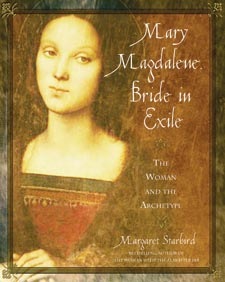Circles of women have gathered through the centuries to support one another with various tasks and needs, including prayer circles, sewing, knitting, and quilting circles. My "14 Steps to Awaken the Sacred Feminine," co-authored with Joan Norton, includes suggestions for setting up circles of people wishing to use Magdalene's story as a template for their own spiritual journey.
Mary Magdalene and the Sacred Geometry of Circles have deep connections that connect her to our human circle gatherings in a special way.
Mary Magdalene’s feast day since the 7th century in the West, borrowed from the Orthodox Eastern rite church, has been set on the 22nd of July.
July is the seventh month of our Western calendars, so we sometimes write the date as 22/7. This strikes me as more than just a simple accident, because 22/7 is also the ratio used to calculate the circumference and area of a circle. We teach this to students in junior high and we call the ratio “pi,” the Greek letter that corresponds to our letter “p.”
In case you’ve forgotten what they taught you in junior high school, any circle that has a diameter of 7 units will have a circumference of 22 units. The fraction reduces to 3 1/7, which means that whatever the diameter is, the circumference will always be slightly more than 3 x the diameter.
So Magdalene’ feast day – 22/7 – is very interesting to those of us who know how important the principle of circles is for women sharing and relating to one another…the “family circle,” the “circle of love,” the circle of influence, quilting circles, prayer circles. A circle often represents community.
We know that “7” is symbolic of the “feminine” as “Complete in herself.” It is also a symbol for the Holy Spirit, because it is the sum of the masculine “3” and the feminine “4.”
Using the “7” from
Magdalene’s feast day as a number symbolic of the Holy Spirit and the Divine Feminine, I’d like to show
you how she embodies the human person as “sacred vessel filled with the
Spirit.”
1. Draw a circle and place a dot in the very center.
2. Now draw a line from the center dot to the edge and label it “7.” That line is called the “radius.” Any line drawn from the center to the edge of a circle is called its "radius" or one "ray."
3. To figure out the circumference of the circle, you must double the radius, so draw a straight line to the opposite side, creating a straight line across the entire circle. That line is called the diameter (value of 14 if the radius is 7 units) and can be multiplied by 22/7 to give the circumference “44."
In the ancient world, the Greek gematria "4" was a feminine number related to matter and the earth (4 corners of the earth, 4 cardinal directions, 4 winds, 4 elements). The phrase “flesh and blood” had a value of 444, so numbers that relate to 4 in any order of magnitude have a symbolic connection with earth/humus and human life…our shared humanity. In this diagram, the “44” of the outer edge suggests the “earthen vessel,” the human person of "flesh and blood," filled with the Spirit (“7”). The image represents the sacred marriage of flesh and divinity, earth and heaven, embodied in each individual person. So, ultimately, each person IS that marriage. Mary Magdalene presents us the archetype of the "earthen vessel filled with the Spirit" and her feast day, 22-7 reflects that understanding of her importance.
Now we will do the calculation for
the area of the circle with the “7” radius. The formula is “pi” (22/7) times
the square of the radius (7 x 7 = 49). 22/7 x 49 is 154. If you use the alternative decimal version of “pi” (3.14)
the result 153.86 is even more obviously connected to Mary Magdalene, because
the Greek gematria of her title “H Magdalhnh” actually adds up to 153. So,
using principles of sacred geometry in use at the time the Gospels were written,
by virtue of her feast day (7/22) and the gematria of her honorific (153), she
is shown to be the “Model” or embodiment of the human person as “sacred
partner” of the Divine.
The "153" is highly significant as a symbolic number in the canon of the Greek geometers. It is the denominator of the ratio used to represent the square root of 3 (265/153) and is a numerical abbreviation for the "vesica piscis" ()--the "Vessel of the Fish" or "Measure of the Fish." This shape is the shared space when two circles are drawn together so that the edge of one passes through the center of the other.
Among the ancients, this shape was called the "Mother of all forms, " the "Matrix," the "Doorway to Life," the "Womb" and the "Bridal Chamber." It's meaning is that of the "Source" or "vessel of creativity," and the symbol was universally associated with the Goddesses of love and fertility in the ancient world. It's no accident that the epithet coined for Mary has gematria (153) that irrevocably associates her with the Goddess of Love and Fertility.
In chapter 21 of John's Gospel, the Jesus is standing on the shore cooking fish and instructs the apostles to throw their nets over the starboard side (the right or "lucky" side) of their boat. When they do, they make an astounding haul of 153 fishes--a metaphor for the "church of the fishes." The woman identified with ecclesia/church/community in the earliest strata of Christian experience was Mary Magdalene, the Bride of the Sacrificed King of the Jews. Her epithet, H Magdalhnh--153--reflects this association with the "Church" as "vessel" or container for the cultural thrust of the "Age of Pisces"--the Fishes.
Please see the article called "Fishes" for further information about the "Lord and Lady of the Age:
http://www.margaretstarbird.net/sacred_fishes.html
